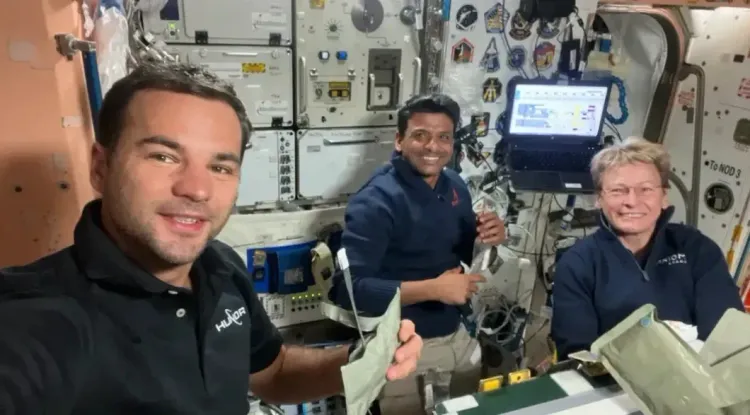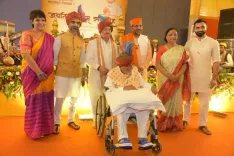Is Shubhanshu Shukla Developing a Brain-Computer Interface in Space?

Synopsis
Key Takeaways
- Shubhanshu Shukla is the first Indian astronaut on the ISS.
- He is developing a brain-computer interface using near-infrared technology.
- The experiment aims to facilitate communication in low-gravity conditions.
- Shukla collaborates with international astronauts, enhancing global scientific cooperation.
- India has contributed several studies to the Axiom-4 mission.
New Delhi, July 3 (NationPress) Shubhanshu Shukla, the inaugural Indian astronaut aboard the International Space Station, is actively engaged in creating a brain-computer interface within the orbital laboratory, as reported by NASA on Thursday.
As a participant in the Axiom Space mission-4, Shukla utilized near-infrared technology to advance this interface in the Columbus laboratory module alongside a fellow astronaut from Poland.
“Ax-4 crewmates Shubhanshu Shukla and Sławosz Uznański-Wiśniewski collaborated in Columbus to explore the use of near-infrared technology for recording brain activity essential for developing brain-computer interfaces,” NASA noted in a blog update.
The experiment involved Uznański-Wiśniewski donning a specialized cap linked via Bluetooth to a laptop, which documented his brain activity, while Shukla fine-tuned the signal quality and calibrated the associated hardware.
This study aimed to investigate how astronauts might leverage their cognitive functions to manipulate or communicate with computers in space, even under the constraints of low-gravity environments.
Dubbed “Thoughts over Gravity” (PhotonGrav), the project is designed to assess the efficacy of near-infrared technology (fNIRS) in low Earth orbit for documenting brain activity needed to formulate brain-computer interfaces (BCI) suited for microgravity conditions.
Previously, Shukla conducted research in the Destiny laboratory module on the ISS to decipher the survival mechanisms of tardigrades — diminutive aquatic organisms — amidst various extreme climates, including microgravity. He deployed sample bags and captured images of algae strains aboard the ISS.
Shukla also examined muscle cell stem cultures under a microscope to gain insights into muscle repair processes in weightlessness.
Moreover, the IAF Group Captain has recorded a video aimed at students, elucidating how the human digestive system adapts to the conditions of space.
Shukla is anticipated to engage with school students and scientists at the Indian Space Research Organisation (ISRO) from his orbital station via ham radio on Friday evening.
Born in Lucknow, Shukla is on a 14-day scientific mission aboard the ISS as part of the Axiom-4 initiative, with three fellow astronauts from the US, Poland, and Hungary.
The Ax-4 crew is set to carry out approximately 60 scientific investigations and commercial endeavors in microgravity, representing 31 countries, including the US, India, Poland, Hungary, Saudi Arabia, Brazil, Nigeria, UAE, and various European nations.
India, through ISRO, has contributed seven meticulously selected studies for this mission.






